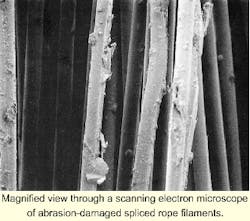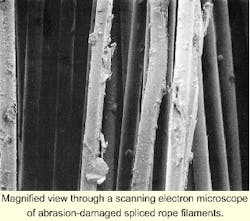ULTRA-DEEP ENGINEERING: UK study simulating strains of long-term service on long polyester ropes
Future floating production systems will be moored in very deep water using advanced technology ropes. At this stage, polyester is the most favored material, mainly on the basis of cost.
Currently, risers for a steel catenary mooring in harsh environments must be twice as long as the water depth, to accommodate the floating vessel's excursions. A polyester rope taut mooring system can theoretically reduce the ratio to 1.5 times the water depth or less. This represents potentially a major saving, given that riser cost is often 30-40% of full field expenditure.
However, while there have been plenty of laboratory experiments to establish the mechanical property and heat buildup characteristics of full-scale polyester ropes under installation, drift and storm conditions, there has been little investigation into the ropes' mechanical properties following long periods of load cycling.
Durability of the rope is also unknown - how much strength loss will occur over time, and will the fiber finish survive for 20 years? Most strength testing to date has been relatively simplistic, based on stretch/relax motions rather than imitating real-life random loadings, involving short sharp jerks or long slow pulls.
Until the present, no facility has existed to simulate this variability, but in the absence of comprehensive test results, mooring system designers cannot evaluate polyester ropes with confidence.
Address stress issues
In Britain, a consortium of the National Engineering Laboratory and rope technology consultants TTI are attempting to address these issues. They are midway through a deepwater polyester mooring line study program sponsored by five oil companies, rope manufacturers, classification societies, the UK Health & Safety Executive and the US' Minerals Management Service (MMS).
The study, which is being conducted at NEL's test facilities in East Kilbride, Scotland, includes fatigue tests on polyester rope samples ranging in size from 10 tons to 250 tons, in order to evaluate the material's durability and long-term behavioral properties. Work is due to be completed by the end of February 2002.
Previously, NEL had mounted fiber rope fatigue tests for major operators of up to 1 million cycles, but that represents just 2% of a typical lifetime for a permanent floating production, storage, and offloading (FPSO) vessel mooring system over 20 years. Analysis of the yarns and strands has suggested early signs of axial compression and internal abrasion.
It is unknown whether at the end of the design life this could lead to significant strength loss. However, quantifying strength loss is a requirement of system designers, and will likely have to be incorporated into certifying authorities' classification documentation or safety case applications. The current durability study incorporates three main components:
- Development of a suitable stochastic load spectrum to model full-scale mooring line patterns.
- A test program using a project-developed stochastic load spectrum, rather than sine wave, in part to limit the cost of extended testing. The load spectrum will represent the actual planned service life - around 15 years - with true long-term service loading conditions built in such as zero-load components in the leeward lines during storm conditions, to ascertain the effects of axial compression on strength loss. The ropes under test (three sizes up to 120 tons nominal break strength) are then due to be examined for fiber degradation. Marine finish loss will also be measured.
- A methodology for assessing durability will also be formulated. This will allow mooring line designers to evaluate strength loss over the design life, to model the influence of strength loss on rope properties and thereby gauge mooring system response. This methodology will also include guidelines for evaluating continued fitness for purpose and suggested intervals at which this process should occur.
Transducer initiative
TTI is leading another rope initiative called Oscar. The aim is to develop a cost-effective optical scanning apparatus for ropes which would permit remote detection of tensile property changes or deterioration in long lengths of mooring, towing and lifting ropes. No such technique currently exists for deepwater moorings, so platform operators must either use redundant moorings or establish property changes through phased removal and testing of leg sections. Both these methods are expensive and unsatisfactory, according to TTI. The project has four main objectives:
- Development of optical fiber strain transducers that can be integrated into the ropes so that they pick up only a controlled proportion of the longitudinal rope strain. These would also be sufficiently robust to resist rope strains of up to 10.5%, pressures up to 150 bar and repeat fatigue loadings over a 20-year design life. If successful in longer and larger ropes, this would be the first proven technique for monitoring local tensile properties in such systems.
- Design of a jumper or ROV-accessible terminations to permit construction of a ruggedized OSCAR system in a subsequent joint industry project.
- Demonstrating the capability of a suitable fiber optic interrogation system to detect changes in transducer strain of magnitudes not exceeding 25% and over lengths not exceeding 10 meters.
- Limiting costs of such a system to 10% of the normal mooring line outlay. A commercialized OSCAR could have a major impact on the safety of FPSOs through reducing the risk of mooring failure and the attendant pollution hazards. Partners in the project are Vermeire, Cousin Trestec, Selantic Fibre, Leuveco, Strathclyde University and BPP Technical Services.

